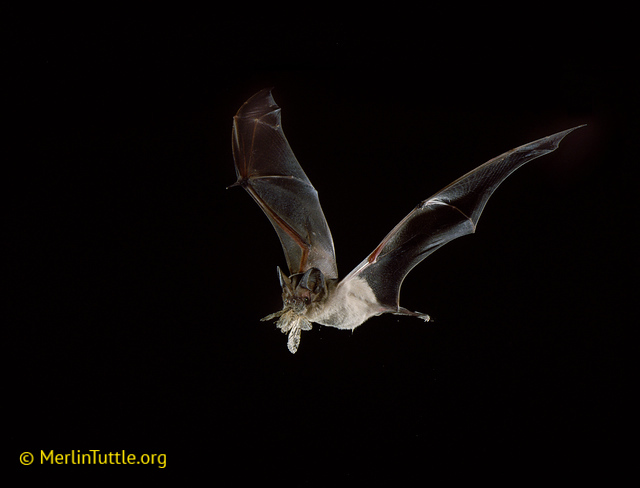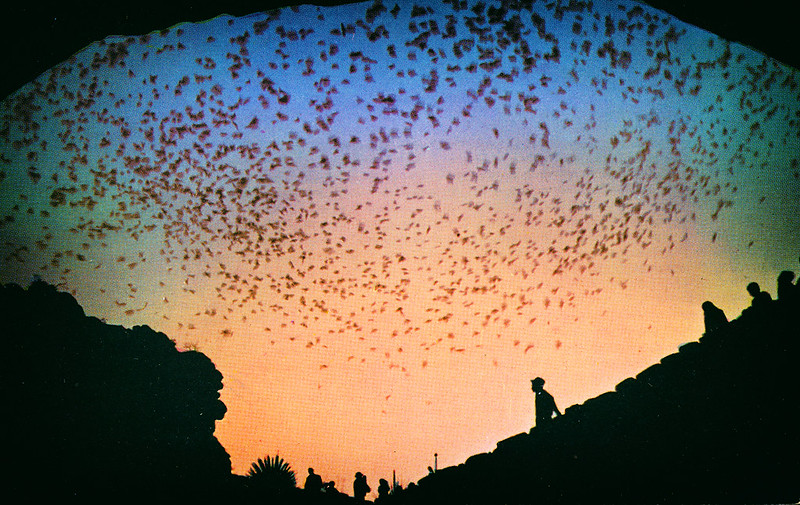Bats are extraordinary creatures that benefit people in myriad ways — the world would be infinitely poorer without them. Bats come in an incredible variety of shapes and sizes and have a great diversity of lifestyles. They are among the most diverse and successful mammals on the planet.
Consider this: Do bats play any part in the production of …
- Bananas?
- Chocolate?
- Coffee?
- Tequila?
It turns out that …
- Wild banana plants — the source of all commercial varieties — require bats for pollination.
- Without bats and birds controlling pests, cocoa bean yields would fall about 30%. That would mean less chocolate!
- Likewise, on coffee farms, bats are voracious eaters of insects that attack these crops.
- The agave from which all tequila is made relies on long-tongued bats for pollination. Where would New Mexico be without tequila for margaritas!?
Let’s take a moment to thank bats for life as we know it!
Bats show up in the fossil record around 50 million years ago, so these creatures have been inhabitants of this planet for a long time! There are more than 1,400 bat species worldwide. In the United States, we have 47 bat species, 23 of which are found in New Mexico. Our state’s species include the big brown bat, hoary bat, little brown bat (now endangered), Mexican free-tailed bat, pallid bat, silver-haired bat, Townsend’s big-eared bat, and western pipistrelle (also known as the canyon bat).
Brazilian free-tailed bats (Tadarida brasiliensis), commonly known as Mexican free-tailed bats, are noted for long, narrow wings and quick, straight flight patterns. These bats are the fastest mammals on earth, and have been recorded flying at speeds of 100 mph. These bats can also fly at heights of up to 10,000 feet! They start searching for food right after sunset and keep hunting throughout the night. We can thank them for eating thousands of insects each night, keeping mosquito and other harmful pest populations at bay.

Mexican free-tailed bats are also the most famous mammals found at Carlsbad Caverns National Park, in southern New Mexico. This large colony wows visitors every evening from spring through fall with spectacular outflights. Bracken Cave Preserve, near San Antonio, Texas, hosts the largest group of Mexican free-tailed bats in the U.S. where as many as 20 million bats are located in a single cave. These bats alone can eat over 200 TONS of insects in one night!
Closer to home, you can see outflights of tens of thousands of Mexican free-tailed bats at El Malpais National Monument in Grants. Bandelier National Monument had a colony of about 10,000 individuals that frequented a cave along the Main Loop Trail between 1986 and 2002. It isn’t known exactly why this colony stopped using the cave: an ecological mystery!
Did you know that bats have had to deal with their own pandemic in North America? A deadly fungus known as White-Nose Syndrome (WNS) was discovered in Upstate New York in 2006. It thrives in cold environments where bats hibernate and has been decimating bat populations by keeping them from sleeping properly (much as you might sleep poorly when you are sick). The lack of sleep causes bats to use up their fat reserves before the end of winter, and consequently starve. The outbreak has resulted in millions of bat deaths and the epidemic is considered the worst wildlife disease outbreak in North American history.

WNS is less likely to be seen in warmer regions and has not been seen in migrating bats. Most Mexican free-tailed bats, for instance, migrate to Mexico and Central America during the winter and WNS has not been seen in this species. WNS has not been identified in New Mexico, but has spread westward to Texas and Oklahoma. Wildlife biologists in New Mexico are watching the spread of this disease with concern and are doing research and taking precautions to protect our bats. This interactive map shows how WNS has spread in the United States since 2006.
Bats may also prove useful in helping humans deal with our own pandemic. Because COVID-19 did not evolve with humans, our bodies have few defenses against it. Bats, on the other hand, have likely been evolving alongside coronaviruses for millions of years. Most importantly, bats might actually help to provide the solution for COVID-19 and other viruses. Bats do not get sick from many viruses that might kill humans, and research on how bats achieve this could hold the key to help us fight this and future outbreaks. This is one of many articles now appearing on this topic.
How you can help bats:
- Learn about bats and teach others about bats.
- Give bats the best habitat and resources to survive.
- Put up bat houses, plant gardens that attract insects, avoid pesticides.
- Avoid caves where bats are hibernating.

We have a single bat who has gotten into our house’s soffit, about 20 feet off the ground. How do we get rid of it? Inside the soffit, it has the potential to get into the house.
Hi Donald — Thanks for reaching out about this. NMSU has some helpful tips both on bat proofing buildings and what to do if a bat does get into your house. You can find that here: https://aces.nmsu.edu/pubs/_l/L202.pdf
Bat Conservation International also has some helpful tips here: https://www.batcon.org/about-bats/bats-in-homes-buildings/
You might be able to get in touch with someone who can safely relocate your bat by calling the New Mexico Wildlife Center at (505) 753-9505. In Los Alamos and White Rock, you can call the non-emergency police dispatch line at (505) 662-8222 and they may be able to connect you with volunteers as well.